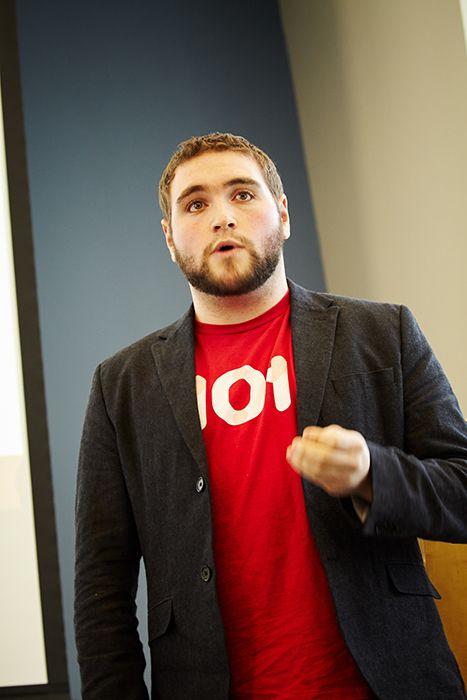There’s No Snoozing in Class With This Chemistry App
Chem101 allows professors to push out exercises for students to do on their devices, increasing classroom engagement
/https://tf-cmsv2-smithsonianmag-media.s3.amazonaws.com/filer/f5/74/f5742e42-d3ac-41e2-9370-9ec7ebc760d2/cell-phones-in-classroom.jpg)
STEM education—that’s science, technology, engineering, and mathematics—receives a lot of attention for its importance, especially as jobs in STEM fields are ever more available and necessary. But Justin Weinberg, the creator of an interactive chemistry app called Chem101, says that even before starting a career in science or technology, students often find the basic lecture-hall and standardized-test teaching format for STEM subjects to be clunky and uninspiring.
While e-books have entered some classrooms, STEM instruction has remained unchanged for nearly as long as the subjects have been taught. With his interactive app, Weinberg, a PhD candidate at Carnegie Mellon University, hopes to inspire a new kind of classroom engagement.
Chem101, his first subject-specific tool, allows students to interact with and respond to an instructor in real time, and receive automated feedback to use in later classroom discussions. Take a topic that vexes a lot of first-year chemistry students: Lewis structures. Lewis structures, also known as Lewis dot diagrams, are two-dimensional drawings that show how molecules in an element are connected, as well as the shape of the molecule. During a lecture, students can use 101 to practice drawing these structures, which educators can then view, review and correct if needed. After a pilot study last fall, the app is being used at several major U.S. universities with much favorable feedback.
Weinberg talked to Smithsonian.com about his vision for transforming STEM education from a passive to an interactive process.
Where did the idea for 101 originate?
Many of the ideas and hypotheses in 101 are based from my own teaching experience. I’ve been teaching forms of STEM for nearly a decade as both a private tutor and a university teaching assistant at Carnegie Mellon, where I am currently a PhD candidate in chemical engineering. Needless to say, I’ve witnessed the struggles that so many students have when they take math and science courses in college.
The real inspiration came from when I co-created a chemistry tutoring app called Chem Pro, which achieved over 500,000 downloads organically. The fact that so many students were seeking help outside of their courses made me realize that the way STEM courses are being taught is fundamentally broken. Over time, that realization has turned into 101’s mission, which is to transform the STEM lecture from a passive learning experience to an active learning experience.

How did your experience as a STEM student and teacher influence the app build and design?
The biggest influence on Chem101’s design actually came from the existing products on the market, because they taught us what not to do. The truth is that online STEM interactives, such as modules for drawing chemical structures, are not new and have actually been around for roughly 20 years. However, these interactives are often so hard to navigate and frustrating to use for students that they only make it more difficult for them to understand STEM concepts. That’s why our number one goal is to make our interactives as easy to use as possible. Education technology should make it more likely for students to succeed, not make it more difficult.
Why start with chemistry?
Simply because it’s what our team knows best. Independent of our team, chemistry is a great starting point because it is notorious for causing student frustration and high failure and dropout rates in college courses.
What's the user experience for students and educators using 101?
In the middle of a lecture, a professor uses Chem101 to create an assignment with one or more built-in problems and then pushes it out over the network to all student devices.
Students are notified of the assignment via a push notification. They open the Chem101 app and respond to the problems by completing the activities, such as drawing chemical structures, on their devices. When students submit their answers, they receive personalized feedback if they make a mistake, with the option of retrying the problem.
The professor receives the results of each problem in real-time. Chem101 provides the professor with the number of students that completed the problem correctly as well as what the three most common mistakes are. The professor can then use these results to promote a class discussion about common misconceptions.
How are students and educators responding so far?
The response from both sides has been incredible. Last fall, we piloted Chem101 with 2,000 students across 8 colleges and universities, including Carnegie Mellon, Columbia University, and the University of Cincinnati. After the pilot, 40 percent of students said using Chem101 made them more interested in chemistry, and students who learned Lewis structures using Chem101 performed up to 200 percent better compared to those who used traditional learning tools.
Is the app free for students if purchased by the institution? What's the pricing like?
Professors can opt to have their students purchase a subscription to Chem101 as part of their course fees or pay for a site license to remove the student costs. Either way, Chem101 is currently $5 per student per course.
How did you select partner institutions for the pilot study and beyond?
It’s a mix of both. At first I did a lot of reaching out to find professors willing to try out a product that had never been tested before. While we still do a good amount of that, we now get professors approaching us because they’ve heard good things about the product.
Any plans to expand to other subjects or other grade and learning levels?
We’ll be focused on chemistry for the near future but look forward to hitting other STEM subjects soon.
/https://tf-cmsv2-smithsonianmag-media.s3.amazonaws.com/accounts/headshot/brittany_headshot_crop.jpg)
/https://tf-cmsv2-smithsonianmag-media.s3.amazonaws.com/accounts/headshot/brittany_headshot_crop.jpg)